#gorgon medusa
Explore tagged Tumblr posts
Text
Hi my name is Μέδουσα and I’m a hideous chimeric gorgon with a gaze that humans say scares off intruders and evil spirits (that's how I got my name) with black vipers that reach my shoulders and orange eyes like the volcanic pits of Asphodel and a lot of people tell me I look like Τυφῶν (AN: if u don't know who he is get da hell out of here!). I'm not related to Aργος Πανόπτης but I wish I was because he's a major fucking hottie. I'm mostly dragon but my tusks are jointed insect legs. I have dark grey skin. I'm also a murderous semi-feral beast, and I go to a mountainous cave on the island of Sarpedon where I recently gave birth (I'm mortal). I'm nightmarecore (in case you couldn't tell) and I wear mostly stolen cloaks. I love magical objects and I steal all my trinkets from Cretians I petrify. For example today I was wearing a black chlamys, a grey chiton with holes in the back for my 2 pairs of wings, and no undergarments. I was wearing kohl on my lashes, and my tunnel earrings with the souls of my immortal sisters Stheno and Euryale watching me through them. I was flying outside the cave. It was dark and the evening sun burned red, which I was very happy about. Περσεύς stared at me. I put up my middle finger at him.
#Μέδουσα is Medusa Τυφῶν is Typhon Aργος Πανόπτης is Argus Panoptes Περσεύς is Perseus#medusa continues to rotate in my head#my immortal#my immortal copypasta#ebony darkness dementia raven way#shitpost#autismposting#ancient greek mythology#Ancient Greek pantheon#archaic medusa#gorgon medusa#Perseus#typhon#Argus Panoptes#theogony
0 notes
Text
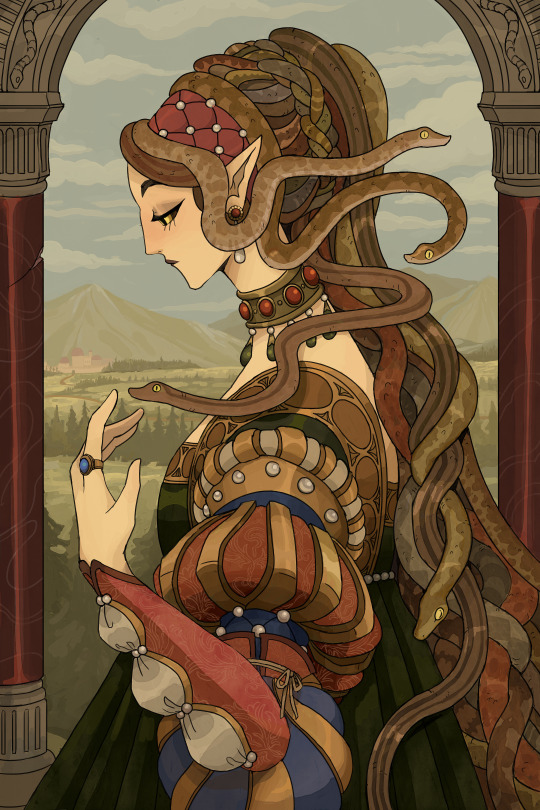
-Medusa-
I've had this sitting around as a sketch for awhile, finally had time to finish it! Hoping to do more mythology illustration this year.
58K notes
·
View notes
Text
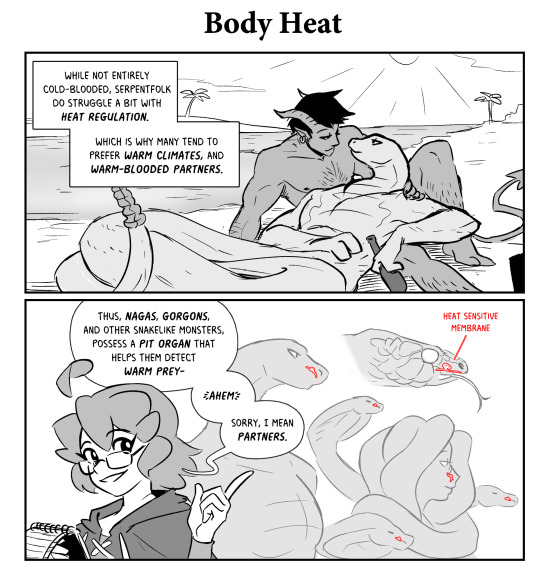

Monster Researcher Eclair discusses Serpentfolk's Specialized Organs (not those ones)
Hang in there, Andie.
9K notes
·
View notes
Photo

There is a deluxe "Supa" reissue of this collection that includes A FULLY PLAYABLE BOARDGAME!




Going out into left field again with a double LP, Warfaring Strangers: Darkscorch Canticles, from Numero Group. It is a 16-song collection of obscure 1970s bands with names like Stone Axe, Wizard, Medusa and Hellstorm. The D&D connection should be self-evident.
Heavy metal is, in a lot of ways, Dungeons & Dragons’ older brother. Born out of Led Zeppelin’s obsession with Lord of the Rings and Black Sabbath’s thunderous occult riffs, metal is a natural soundtrack for roleplaying games (seriously, listen to the first Bolt Thrower album and try to not think of Warhammer). Metal and RPGs attracted outsiders of similar stripes. They also courted controversy by embracing a certain amount of sinister imagery. Both got burned, yet both went on to become mainstays of the cultural landscape.
You’d probably be hard pressed to describe the tracks on Warfaring Strangers as heavy metal. This is early stuff, made by kids who never went anywhere, who were imitating their musical heroes and acting out sword and sorcery fantasies through music. It is about as removed from modern metal as the modern gaming industry is from the wargaming scene of the early 70s. Check it out on Spotify, though, you might find a solid groove or two (my favorite is probably “Sorcerer,” by Junction or “Slave of Fear,” by Stone Axe).
The art direction is kind of worth the price of admission on its own. The cover looks like the back of a million school notebooks from the 70s and 80s. The interior art is drawn on blue lined graph paper. It is glorious.
#Heavy Metal#Warfaring Strangers#Numero Group#Gorgon Medusa#Stone Axe#Junction#Occult#black sabbath#led zeppelin#Lord of the Rings
44 notes
·
View notes
Text

Wisptober Day 14: Layers
“A young woman cloaked in layers upon layers of colourful shawls wanders the empty streets of an emptier city. She dances nimbly through the odd spires sprouting from the pavement and hums a sort of hissing tune.”
ALMOST CAUGHT UP! Going to post todays one in a few hours.:)
#btw this color palette is what happens when i dont know what colors to use anymore!XD#wisptober#my art#illustration#fantasy#wisptober 2024#medusa#gorgon
2K notes
·
View notes
Text



Big eyes
#ocs#my art#drawing#love letter#digital art#gorgon#medusa#snakes#traditional art#girls#pink#wlw#character design#fantasy
2K notes
·
View notes
Text

#art#digital art#artists on tumblr#fantasy#my art#illustration#character design#drawing#original character#character art#gorgon#medusa#snake#wip
2K notes
·
View notes
Text
Everyone needs at least one ride or die when the heartbreak happens.
Snakes of a feather and all that.

#illustrator#illustration#digital artist#artist on tumblr#gleafer art#good omens#good omens art#crowley#good omens crowley#medusa illustration#Medusa#gorgon#besties#girl talk#ride or die#ineffable divorce
2K notes
·
View notes
Text

She's a snecc. A little sneccy snecc. Slitherin' around like a lil' sneccy snecc.
#medusa#medusa gorgon#soul eater#fanart#digital art#artwork#artists on tumblr#digital illustration#digital painting#drawing#fandom#art#my art#procreate#villainous#antagonist#she was my unhealthy obsession as a teenager next to stein my angst is not behind me
2K notes
·
View notes
Note
something I don’t get about the disability metaphor is that for eureka monsters obviously it harms another person to eat them. the help a disabled person needs doesn’t actively harm or kill another person. Maybe it’s a difference in perspectives that cannot be resolved
(What I’m about to write could potentially sound very fucked up at first so I’m going to need to trust everyone to read the whole thing before forming an opinion.)
Also this message and response references these two posts.
Eureka’s stance on disabled people is that they (including myself writing this) are, or at least can often be, burdens.
Disabled people often require more resources to live than they are able to “give back,” which, in our capitalist and artificial-scarcity-based economy, is just about the worst thing a person can do.
Anti-ableism sentiment often focuses on the idea that “disabled people aren’t burdens, that they’re just as good and capable as everyone else,” but if they were, they wouldn’t be “disabled” would they? When you say stuff like that, you’re conceding that a person’s worth is determined by how capable they are at doing work, and then having to bend over backwards to justify thinking that a person without arms is just as valuable as a person with arms. Eureka is asking you to decouple a person’s value from how much net resources they can produce.
Often times also, the resources that real disabled people consume are human resources, and those human resources are very much capable of suffering for it. Nurses are overworked, around-the-clock care is absolutely physically and mentally exhausting, people who have to care for their elderly or otherwise disabled relatives on top of their regular jobs don’t get to have social lives or hobbies, etc.
To this end, we wrote the monsters in Eureka to be unquestionably people who “cause damage” to society by literally eating up human resources, because they have to to live, they have no other choice unless they want to just die. Your friend is gone from your life because he has to spend all his free time caring for his comatose wife after a freak car accident. Your friend is gone from your life because a vampire randomly ate him. Providing a metaphor isn't all the monsters are doing, they just work well through that lens.
And then Eureka forces you to look at these people as people, and make up your mind as to whether they have value and a right to prologue their own existence. We can’t force you to agree that they do, but if you think they don’t, then you’ll have to make that argument looking at an intelligent person with a life rather than a pure hypothetical or statistics on a chart.
There are some monsters in Eureka where, if the economy or societal structures were changed, they would stop being such severe drains on resources and could exist harmlessly within society, and there are some monsters where no imaginable amount of societal change would solve the problems they cause. This is true of disabled people IRL as well. Some of them would require no further assistance with living if certain things about society changed, and others would still require a massive amount of human resources.
And even when it’s not necessarily human resources, the extra resources that disabled people need also cause huge energy expenditure and create huge amounts of plastic waste, which are things that contribute to global warming and pollution, which do have significant harmful effects on everyone’s lives. Despite this, they are still “worth it” to keep around.
As for actively causing harm, that happens too. I randomly scrolled past this post after we got this message and saved it so I could link it here.
This person and their family had to cause a big stink in a restaurant just to get an accommodation that they needed, and to us reading it from their perspective, we’re obviously on their side, but I can assure you that the overworked staff at that restaurant didn’t see it that way. They saw the disabled person as an aggressive Karen whom they would never in a million years want to have to provide customer service to. The disabled person & family had to get aggressive, and ruin the staff’s day, to get what they needed. That’s actively causing harm - harm we all agreed was justified to cause - but harm nonetheless.
Plastic straws aren’t that big of a deal for global pollution, but even if they were, the point is that this person still would have needed a straw. It doesn’t line up one-to-one, because metaphors rarely do, but a vampire asking if they can drink someone’s blood, and being told No, may find themselves in much the same position. (And if you bring up that some people find vampires really sexy, you’re missing the point. “I would give them a straw if they had sex with me.” is not actually a great thing to announce about yourself.)
I can also come up with an example from my own life. I personally am very sensitive to noise and noise pollution. If there’s music playing at a public space, I usually can’t handle it. (Earplugs don’t work for other reasons I won’t get into - plus, if I just deafen myself to all sound, how can I socialize with anyone in this public space?)
If I want to exist in this space, I will have to actively cause harm to everyone there, or else stop existing in that space. I will have to go up to whoever is responsible and ask them to turn off the music, actively taking it away from everyone else who was enjoying it. I have to take action to ruin their good time if I want to exist in that space at all, and they might, very understandably, be pissed off at me for doing that. Because, like I said in this other post, the people that monsters eat do have a right to prevent themselves from being eaten by monsters. We aren't proposing that the solution is everyone has to line up to be mauled to death by monsters or else they're a bad person.
Who has a greater right to enjoy themselves in that space? That’s the kind of question that Eureka poses, and makes you consider both sides as human being rather than denoting one as just an ontologically evil villain to be destroyed.
We actually don't know of perfect solutions to all the problems presented by the existance of monsters in Eureka, we just know that "exterminate all people who are parasites and burdens to society" ain't it.

#indie ttrpgs#disability#ttrpgs#ableism#ttrpg#ttrpg tumblr#indie ttrpg#ttrpg community#vampire#werewolf#gorgon#rpg#tabletop#monster#monster girl#vampirism#roleplaying#medusa#mythical creatures#monsters#eureka#eureka: investigative urban fantasy
893 notes
·
View notes
Text
The truth about Medusa and her rape... Mythology breakdown time!
With the recent release of the Percy Jackson television series, Tumblr is bursting with mythological posts, and the apparition of Medusa the Gorgon has been the object of numerous talks throughout this website… Including more and more spreading of misinformation, and more debates about what is the “true” version of Medusa’s backstory.
Already let us make that clear: the idea that Medusa was actually “blessed” or “gifted” by Athena her petrifying gaze/snake-hair curse is to my knowledge not at all part of the Antique world. I still do not know exactly where this comes from, but I am aware of no Greek or Roman texts that talked about this – so it seems definitively a modern invention. After all, the figure of Medusa and her entire myth has been taken part, reinterpreted and modified by numerous modern women, feminist activist, feminist movements or artists engaged in the topic of women’s life and social conditions – most notably Medusa becoming the “symbol of raped women’ wrath and fury”. It is an interesting reading and a fascinating update of the ancient texts, and it is a worthy take on its own time and context – but today we are not talking about the posterity, reinvention and continuity of Medusa as a myth and a symbol. I want to clarify some points about the ACTUAL myth or legend of Medusa – the original tale, as told by the Greeks and then by the Romans.
Most specifically the question: Was Medusa raped?
Step 1: Yes, but no.
The backstory of Medusa you will find very often today, ranging from mythology manuals (vulgarization manuals of course) to Youtube videos, goes as such: Medusa was a priestess of Athena who got raped by Poseidon while in Athena’s temple, and as a result of this, Athena punished Medusa by turning her into the monstrous Gorgon.
Some will go even further claiming Athena’s “curse” wasn’t a punishment but a “gift” or blessing – and again, I don’t know where this comes from and nobody seems to be able to give me any reliable source for that, so… Let’s put this out of there.
Now this backstory – famous and popular enough to get into Riodan’s book series for example – is partially true. There are some elements here very wrong – and by wrong I do mean wrong.
The story of Medusa being raped and turned into a monster due to being raped does indeed exist, and it is the most famous and widespread of all the Medusa stories, the one people remembered for the longest time and wrote and illustrated the most about. Hence why Medusa became in the 20th century this very important cultural symbol tied to rape and the abuse of women and victim-blaming. HOWEVER – the origin of this story is Ovid’s Metamorphoses, from the first century CE or so. Ovid? A Roman poet writing for Roman people. “Metamorphoses”? One of the two fundamental works of Roman literature and one of the two main texts of Roman mythology, alongside Virgil’s Aeneid. This is a purely Roman story belonging to the Roman culture – and not the Greek one. The story of Medusa’s rape does not have Greek precedents to my knowledge, Ovid introduced the element of rape – which is no surprise given Ovid turned half of the romances of Greek mythology into rapes. Note that, on top of all this, Ovid wasn’t even writing for religious purposes, nor was his text an actual mythological effort – he wrote it with pure literary intentions at heart. It is just a piece of poetry and literature taking inspiration from the legends of the Greek world, not some sort of sacred text.
Second big point: The legend I summarized above? It isn’t even the story Ovid wrote, since there are a lot of elements that do not come from Ovid’s retelling of the story (book fourth of the Metamorphoses). For example Ovid never said Medusa was a priestess of Athena – all he said was that she was raped in the temple of Athena. I shouldn’t even be writing Athena since again, this is a Roman text: we are speaking of Minerva here, and of Neptune, not of Athena or Poseidon. Similarly, Minerva’s curse did not involve the petrifying gaze – rather all Ovid wrote about was that Minerva turned Medusa’s hair into snakes, to “punish” her because her hair were very beautiful, and it was what made her have many suitors (none of which she wanted to marry apparently), and it is also implied it is what made Neptune fall in love (or rather fall in lust) with her. I guess it is from this detail that the reading of “Athena’s curse was a gift” comes from – even though this story also clearly does victim-blaming of rape here.
But what is very fascinating is that… we are not definitively sure Neptune raped Medusa in Ovid’s retelling. For sure, the terms used by Ovid in his fourth book of Metamorphoses are clear: this was an action of violating, sexually assaulting, of soiling and corrupting, we are talking about rape. But Ovid refers several other times to Medusa in his other books, sometimes adding details the fourth-book stories does not have (the sixth book for examples evokes how Neptune turned into a bird to seduce Medusa, which is completely absent from the fourth book’s retelling of Medusa’ curse). And in all those other mentions, the terms to designate the relationship between Medusa and Neptune are more ambiguous, evoking seduction and romance rather than physical or sexual assault. (It does not help that Ovid has an habit of constantly confusing consensual and non-consensual sex in his poems, meaning that a rape in one book can turn into a romance in another, or reversal)
But the latter fact makes more sense when you recall that the rape element was invented and added by Ovid. Before, yes Poseidon and Medusa loved each other, but it was a pure romance, or at least a consensual one-night. Heck, if we go back to the oldest records of the love between Poseidon and Medusa, back in Hesiod’s Theogony, we have descriptions of the two of them laying together in a beautiful, flowery meadow – a stereotypical scene of pastoral romances – with no mention of any brutality or violence of any sort. As a result, it makes sense the original “romantic” story would still “leak” or cast a shadow over Ovid’s reinvented and slightly-confused tale.
Step 2: So… no rape?
Well, if we go by Greek texts, no, apparently Medusa was not raped in Greek mythology, and only became a rape victim through Ovid.
The Ancient Greek texts all record Poseidon and Medusa sleeping with each other and having children, but no mention of rape. And the whole “curse of Athena” thing is not present in the oldest records – no temple of Athena soiling, no angry Athena cursing a poor girl… “No curse?” you say “But then how did Medusa got turned into a Gorgon”? Answer: she did not. She was born like that.
As I said before, the oldest record of Medusa’s romance but also of her family comes from Hesiod’s Theogony (Hesiod being one of the two “founding authors” of Greek mythology, alongside Homer – Homer did wrote several times about Medusa, but only as a disembodied head and as a monster already dead, so we don’t have any information about her life). And what do we learn? That Medusa is part of a set of three sisters known as the Gorgons – because oh yes, Ovid did not mention Medusa’s sister now did he? How did Medusa’s sisters ALSO got snake-hair or petrifying-gaze if only Medusa was cursed for sleeping with Neptune? Ovid does not give us any answer because again, it is an “adaptational plot hole”, and the people that try to adapt Ovid’s story have to deal with the slight problem of Stheno and Euryale needing to share their sister’s curse despite seemingly not being involved in the whole Neptune business. Anyway, back to the Greek text.
So, you have those three Gorgon sisters, and Medusa is said to be mortal while her sisters are not. Why is it such a big deal? Because Medusa wasn’t originally some random human or priestess. Oh no! Who were the Gorgons’ parents? Phorcys and Keto/Ceto, aka two sea-gods. Not just two sea-gods – two sea-gods of the ancient, primordial generation of sea-gods, the one that predated Poseidon, and that were cousins to the Titans, the sea-gods born of Gaia mating with Pontos.
So the Gorgons were “divine” of nature – and this is why Medusa being a mortal was considered to be a MASSIVE problem and handicap for her, an abnormal thing for the daughter of two deities. But let’s dig a bit further… Who were Phorcys and Ceto? Long story short: in Greek mythology, they were considered to be sea-equivalents of Typhon and Gaia. They were the parents of many monsters and many sea-horrors: Keto/Ceto herself had her name attributed and equated with any very large creature (like whales) or any terrifying monster (like dragons) from the sea. The Gorgons themselves was a trio of monsters, but their sisters, that directly act as their double in the myth of Perseus? The Graiai – the monstrous trio of old women sharing one eye and one tooth. Hesiod also drops the fact that Ladon (the dragon that guarded the golden apples of the Hesperids), and Echidna (the snake-woman that mated with Typhon and became known as the “mother of monsters”) were also children of Phorcys and Ceto, while other authors will add other monster-related characters such as Scylla (of Charybdis and Scylla fame), the sirens, or Thoosa (the mother of Polyphemus the cyclop). Medusa herself is technically a “mother of monsters” since she birthed both Pegasus the flying horse and Chrysaor, a giant. So here is something very important to get: Medusa, and the Gorgons, were part of a family of monsters. Couple that with the absence of any mention of curses in these ancient texts, and everything is clear.
Originally Medusa was not a woman cursed to become a monster: she was born a monster, part of a group of monster siblings, birthed by monster-creating deities, and she belonged to the world of the “primordial abominations from the sea”, and the pre-Olympian threats, the remnants of the primordial chaos. It is no surprise that the Gorgons were said to live at the edge of the very known world, in the last patch of land before the end of the universe – in the most inhuman, primitive and liminal area possible. They were full-on monsters!
Now you might ask why Poseidon would sleep with a horrible monster, especially when you recall that the Greeks loved to depict the Gorgons as truly bizarre and grotesque. It wasn’t just snake-hair and petrifying gaze: they had boar tusks, and metallic claws, and bloated eyes, and a long tongue that constantly hanged down their bearded chin, and very large heads – some very old depictions even show her with a female centaur body! In fact, the ancient texts imply that it wasn’t so much the Gorgon’s gaze or eyes that had the power to turn people into stone – but that rather the Gorgon was just so hideous and so terrifying to look at people froze in terror – and then literally turned into stone out of fear and disgust. We are talking Lovecraftian level of eldritch horror here. So why would Poseidon, an Olympian god, sleep with one of these horrors? Well… If you know your Poseidon it wouldn’t surprise you too much because Poseidon had a thing for monsters. As a sort of “dark double” of Zeus, whereas Zeus fell in love with beautiful princesses and noble queens and birthed great gods and brave heroes, Poseidon was more about getting freaky with all sorts of unusual and bizarre goddesses, and giving birth to bandits and monsters. A good chunk of the villains of Greek mythology were born out of Poseidon’s loins: Polyphemus, Antaios, Orion, Charybdis, the Aloads… And even his most benevolent offspring has freaky stuff about it – Proteus the shapeshifter or Triton half-man half-fish… So yes, Poseidon sleeping with an abominable Gorgon is not so much out of character.
Step 3: The missing link
Now that we established what Medusa started out as, and what she ended up as… We need to evoke the evolution from point Hesiod to point Ovid, because while people summarized the Medusa debate as “Sea-born monster VS raped and punished woman”, there is a third element needed to understand this whole situation…
Yes Ovid did invent the rape. But he did not invent the idea that Medusa had been cursed by Athena.
The “gorgoneion” – the visual and artistic motif of the Gorgon’s head – was, as I said, a grotesque and monstrous face used to invoke fright into the enemies or to repel any vile influence or wicked spirit by the principle of “What’s the best way to repel bad stuff? Badder stuff”. Your Gorgon was your gargoyle, with all the hideous traits I described before – represented in front (unlike all the other side-portraits of gods and heroes), with the face being very large and flat, a big tongue out of a tusked-mouth, snake-hair, bulging crazy eyes, sometimes a beard or scales… Pure monster. But then… from the fifth century BCE to the second century BCE we see a slow evolution of the “gorgoneion” in art. Slowly the grotesque elements disappear, and the Gorgon’s face becomes… a regular, human face. Even more: it even becomes a pretty woman’s face! But with snakes instead of hair. As such, the idea that Medusa was a gorgeous woman who just had snakes and cursed-eyes DOES come from Ancient Greece – and existed well before Ovid wrote his rape story.
But what was the reason behind this change?
Well, we have to look at the Roman era again. Ovid’s tale of Medusa being cursed for her rape at the hands of Neptune had to rival with another record collected by a Greek author Apollodorus, or Pseudo-Apollodorus, in his Bibliotheca. In this collection of Greek myths, Apollodorus writes that indeed, Medusa was cursed by Athena to have her beautiful hair that seduced everybody be turned into snakes… But it wasn’t because of any rape or forbidden romance, no. It was just because Medusa was a very vain woman who liked to brag about her beauty and hair – and had the foolish idea of saying her hair looked better than Athena’s. (If you recall tales such as Arachne’s or the Judgement of Paris, you will know that despite Athena being wise and clever, one of her main flaws is her vanity).
“Wait a minute,” you are going to tell me, “The Bibliotheca was created in the second century CE! Well after Greece became part of the Roman Empire, and after Ovid’s Metamorphoses became a huge success! It isn’t a true Greek myth, it is just Ovid’s tale being projected here…” And people did agree for a time… Until it was discovered, in the scholias placed around the texts of Apollonios of Rhodes, that an author of the fifth century BCE named Pherecyde HAD recorded in his time a version of Medusa’s legend where she had been cursed into becoming an ugly monster as punishment for her vanity. We apparently do not have the original text of Pherecyde, but the many scholias referring to this lost piece are very clear about this. This means that the story that Apollodorus recorded isn’t a “novelty”, but rather the latest record of an older tradition going back to the fifth century BCE… THE SAME CENTURY THAT THE GORGONEION STARTED LOSING THEIR GROTESQUE, and that the face of Medusa started becoming more human in art.
[EDIT: I also forgot to add that this evolution of Medusa is also proved by strange literary elements, such as Pindar's mention in a poem of his (around 490 BCE) of "fair-cheeked Medusa". A description which seems strange given how Medusa used to be depicted as the epitome of ugliness... But that makes sense if the "cursed beauty" version of the myth had been going around at the time!]
And thus it is all connected and explained. Ovid did invent the rape yes – but he did not invent the idea of Athena cursing Medusa. It pre-existed as the most “recent” and dominating legend in Ancient Greece, having overshadowed by Ovid’s time the oldest Hesiodic records of Medusa being born a monster. So what Ovid did wasn’t completely create a new story out of nowhere, but twist the Greek traditions of Athena cursing Medusa and Medusa having a relationship with Poseidon, so that the two legends would form one and same story. And this explains in retrospect why Ovid focuses so much on describing Medusa’s beautiful hair, and why Ovid’s Minerva would think turning her hair into snake would be a “punishment fit for the crime”: these are leftovers of the Greek tale where Medusa was punished for her boasting and her vanity.
CONCLUSION
Here is the simplified chronology of how Medusa’s evolution went.
A) Primitive Greek myths, Hesiodic tradition: Born a monster out of a family of sea-monsters and monstrous immortals. Is a grotesque, gargoylesque, eldritch abomination. Athena has only an indirect conflict with her, due to being Perseus’ “fairy godmother”. Has a lovely romance with Poseidon.
B) Slow evolution throughout Classical Greece and further: Medusa becomes a beautiful, human-looking girl that was cursed to have snake for hair and petrifying eyes, instead of being a Lovecraftian horror people could not gaze upon. Her conflict with Athena becomes direct, as it is Athena that cursed her due to being offended by her vain boasting. Her punishment is for her vanity and arrogant comparison to the goddess.
C) Ovid comes in: Medusa’s romance with Poseidon becomes a rape, and she is now punished for having been raped inside Athena’s temple.
[As a final note, I want to insist upon the fact that the story of Medusa being raped is not less "worthy" than any other version of the myth. Due to its enormous popularity, how it shaped the figure of Medusa throughout the centuries, and how it still survives today and echoes current-day problems, to try to deny the valid place of this story in the world of myths and legends would be foolish. HOWEVER it is important to place back things in their context, to recognize that it is not the ONLY tale of Medusa, that it was NOT part of Greek mythology, but rather of Roman legends - and let us all always remember this time Poseidon slept with a Lovecraftian horror because my guy is kinky.]
EDIT:
For illustration, I will place here visuals showing how the Ancient art evolved alongside Medusa's story.
Before the 5th century BCE: Medusa is a full-on monster



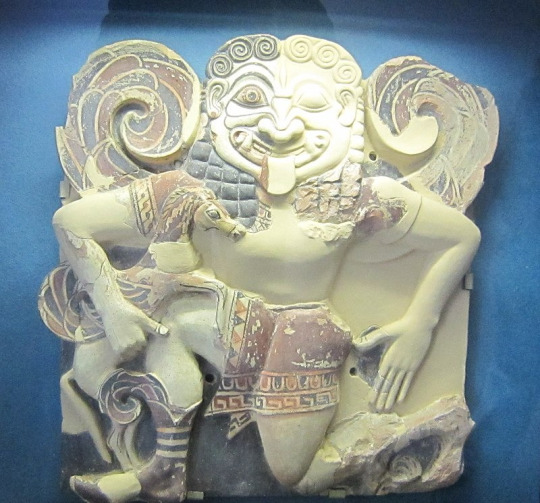

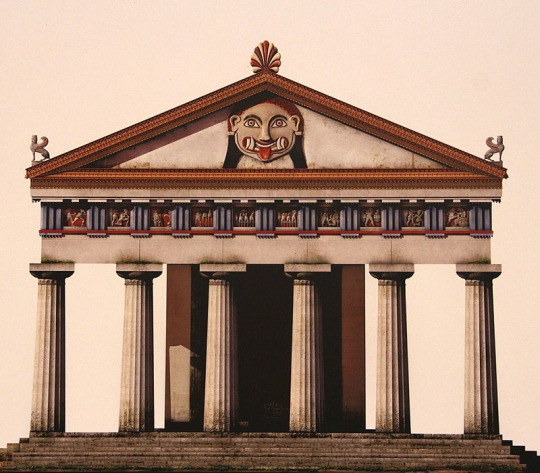
From the 5th century to the 2nd century BCE: A slow evolution as Medusa goes from a full-on monster to a human turned into a monster. As a result the two depictions of the grotesque and beautiful gorgoneion coexist.
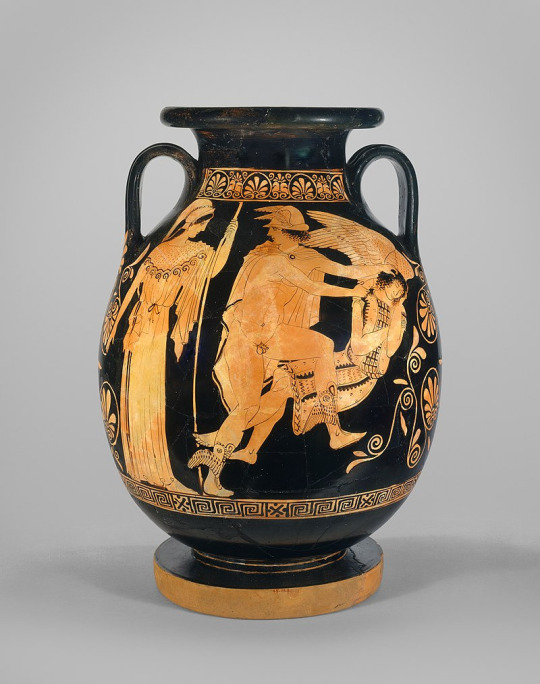


Post 2nd century BCE: Medusa is now a human with snake hair, and just that


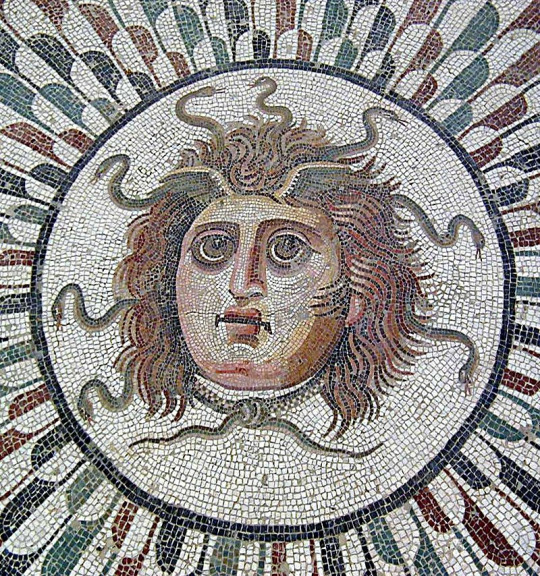
#greek mythology#medusa#gorgon#athena#gorgons#poseidon#neptune#minerva#ovid#rape in mythology#greek monsters#roman mythology
4K notes
·
View notes
Text

810 notes
·
View notes
Text
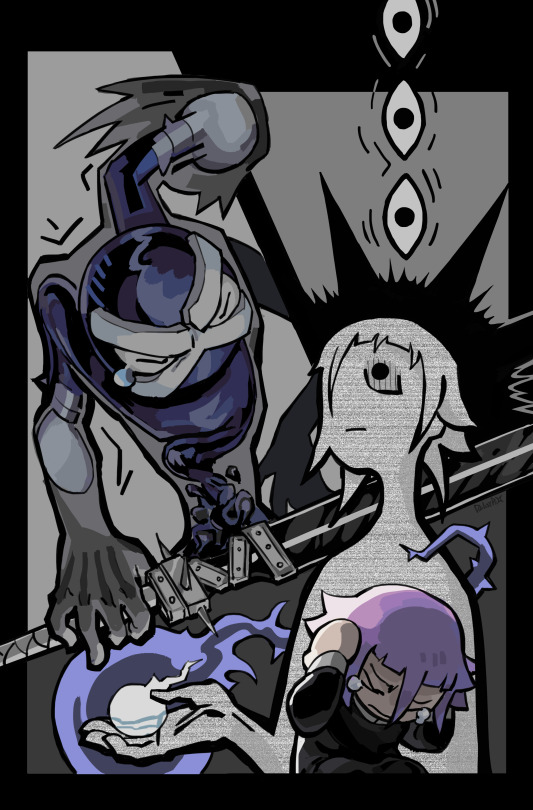
#who put my crona and ragnarok in one body?....YOU!!!(MEDUSA!!!)#crona#crona gorgon#ragnarok#soul eater#listening to “To Ashes and Blood” in the background while drawing...to draw arcane fanart? to draw arcane fanart right???#arcane is supercool though#go check it out if you haven't already... and don't mind me: soul eater's crona is just my comfort character rn
653 notes
·
View notes
Text


Skincare Routine
Monster Researcher Andie continues to study gorgons.
Happy Year of the Snake!
#monster researcher eclair#aka miss not appearing in this comic#monsterfucking cw#gorgon#medusa#oc art#nips on the patreon
7K notes
·
View notes
Photo

Medusa’s Garden by Iren Horrors
This artist on Instagram
6K notes
·
View notes
Text

I could finally figure out a design for her for my AU everybody run
#art#fanart#my art#original art#splatoon#splatoon art#splatoon fanart#Splatoon fan art#Splatoon au#Splatoon mythology au#mythology au#au#Splatoon Frye#frye#frye onaga#frye splatoon#frye fanart#snake#Medusa#gorgon
786 notes
·
View notes